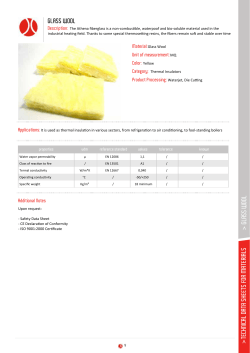
Physics 6C Ch23 Practice solutions
PHYSICS 6C Ch.23 Practice Problems SOLUTIONS 1) The observer in the figure is positioned so that the far edge of the bottom of the empty glass is just visible. When the glass is filled with water (n=1.33), the center of the bottom of the glass is just visible to the observer. Find the height, H, of the glass, given that its width is W=6.2cm. We need to use right triangles here. Snell’s Law says Plugging in n1=1 and n2=1.33, and W=6.2cm, we do some algebra and get H=3.6cm 2) A glass paperweight with an index of refraction n rests on a desk, as shown. An incident ray of light enters the horizontal top surface of the paperweight at an angle θ=77° to the vertical. Find the minimum value of n so that there is total internal reflection on the left side, as shown. Snell’s Law applied to the top and the side give: Using the trig identity sin(90-θ)=cos(θ) gives us: Some algebra (and trig) yields our answer: n=1.4 3) An air wedge is formed by placing a human hair between two glass plates on one end, and allowing them to touch on the other end. When this wedge is illuminated with red light (λ=771nm), it is observed to have 179 dark fringes. How thick is the hair? This ray is not shifted because it reflects from a lower index (glass to air) This ray is shifted because it reflects from a higher index (air to glass) The 2 rays that are interfering have a relative phase shift, so they are already out of phase. Thus for dark fringes we use the formula 2t=mλ. Set m=179 and solve for t: t clas.sa.ucsb.edu/vincezaccone (179)(771 109 m) 6.9 105 m 2 PHYSICS 6C Ch.23 Practice Problems SOLUTIONS 4) The diffraction pattern shown in the figure is produced by passing He-Ne laser light (λ=632.8nm) through a single slit and viewing the pattern on a screen 1.5m behind the slit. a) What is the width of the slit? b) If monochromatic yellow light of wavelength 591nm is used with this slit instead, will the distance in the figure be greater or less than 15.2cm? part (b) Longer wavelength = wider fringes. The distance from the center to the 2nd dark fringe is 7.6cm (half of the distance shown). Use the formula y m R m with m=2. W (2)(591 109 m) W (1.5m) 2.4 10 5 m 0.076m 5) Experiments show that the ground spider Drassodes cupreus uses one of its several pairs of eyes as a polarization detector. In fact, the two eyes in this pair have polarization directions that are at right angles to one another. Suppose linearly polarized light with an intensity of 825 W/m2 shines from the sky onto the spider, and that the intensity transmitted by one of the polarizing eyes is 212 W/m2. a) For this eye, what is the angle between the polarization direction of the eye and the polarization direction of the incident light? b) What is the intensity transmitted by the other polarizing eye? Use I=I0·cos2(θ) For part a) we are given I and I0: For part b) we know the angle is 90° from the first eye, so we use θ=30°: 6) The asteroid Ida is orbited by its own small “moon” called Dactyl. If the separation between these two asteroids is 2.5km, what is the maximum distance at which the Hubble Space Telescope (aperture diameter 2.4m) can still resolve them with 550nm light? Use Rayleigh’s criterion to find the θmin. 550 109 m 1.22 2.8 10 7 rad D 2.4m From the triangle in the picture we get y 2500m tan() L 8.9 109 m 7 L tan(2.8 10 rad) min 1.22 clas.sa.ucsb.edu/vincezaccone
© Copyright 2025





















